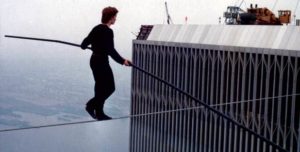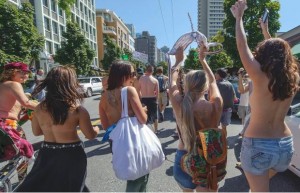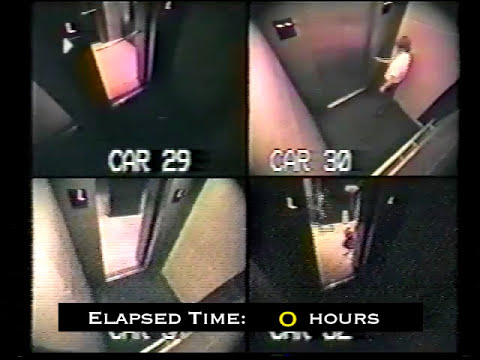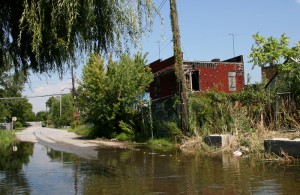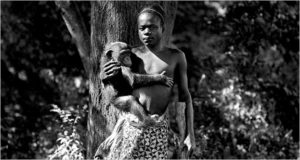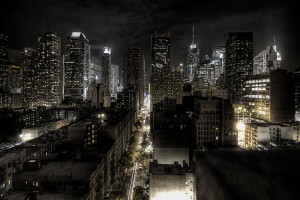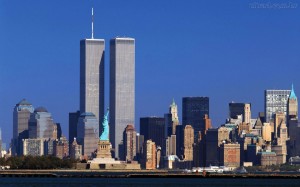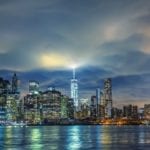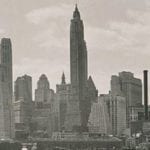10The Parrots Of Brooklyn
New York is not particularly well known for its wildlife, unless you’re talking about rats and pigeons. However, an amazing diversity of creatures make their home in the city, including turtles, raccoons, frogs, and several dozen species of bird. Among the crows and seagulls, there is one species that seems decidedly out of place—the quaker parrot. Indigenous to South America, the bright green parrot has taken up residence in the borough of Brooklyn. The precise origin of these birds is a mystery; some claim they were released by a pet store that went out of business, or escaped from the Brooklyn Botanical Gardens. The most likely explanation is that a large, crated shipment of birds sent from South America for the pet trade was somehow opened at nearby JFK Airport. Although the birds can be found in several places throughout the borough, perhaps the most popular place to see them is nested on the power lines of Brooklyn College’s athletic field.
9The Artistic Crime Of The Century
In 1974, Frenchman Philippe Petit perpetrated what has since been called the “artistic crime of the century” when he walked the 61 meters (200 ft) between the twin towers of the World Trade Center on a tightrope, more than 400 meters (1,300 ft) above the street. This was no mere whim; the stunt took years of planning. Petit snuck into the towers to do research wearing the disguises of construction workers and office employees, forged identification cards, and even did aerial reconnaissance. On the morning of August 7, Petit and his co-conspirators used a bow and arrow to pass increasingly larger ropes across the chasm until they could string up the steel cable he would walk on for 45 minutes, passing back and forth between the buildings eight times. It was a spellbinding routine; Petit laughed gleefully as he ran, bounced, and sat on the wire, curtsying to the police officers massing on the rooftops. Eventually, he was warned a helicopter was coming for him, and the falling rain caused him to turn himself in. The incident brought much-needed good publicity to the newly built World Trade Center, which had been seen as an eyesore. Charges against Petit were dropped in exchange for a community service act for children in Central Park—a high-wire walk over Turtle Pond. He has since gone on to write a series of books and perform all over the world, including more than a dozen times in New York City.
8Topless Women
Years ago, Manhattan’s Times Square was a virtual Sodom and Gomorrah of peep shows, strip joints, and erotic video stores. Only a handful of these institutions remain, but you don’t need to duck into a den of iniquity to get a glimpse of skin—it is perfectly legal for women to walk around topless in New York City. In 1992, a landmark ruling by the New York Supreme Court altered penal law 245.01 (which governs public indecency), allowing women to go shirtless as men do. Certainly, it’s a rarely exercised privilege but earlier this year the city still felt the need to remind the police force that bare breasts are not a crime. In August, a veritable army of half-nude women gather in Central Park to celebrate International Go Topless Day, an event which never fails to draw a crowd.
7The Elevator Ride From Hell
The skyline of New York was born from the elevator; without it, buildings more than a few stories tall would be impractical. And despite what television and movies would have you believe, elevators are extremely safe. However, they are rather finicky contrivances, and it is not uncommon for one to get stuck. Usually, some minor mechanical issue is to blame and is fixed within minutes. But in 1999, New Yorker Nicholas White experienced a claustrophobic’s worst nightmare when the elevator he was riding in became stuck for 41 hours. White, who worked in the McGraw-Hill Building in Manhattan’s Rockefeller Center, was a production manager for Business Week. He was working late one Friday evening when he decided to take a smoke break. He rode the elevator down, had a cigarette, and was attempting to return to the 43rd floor when his elevator became stuck. White attempted to use the intercom and activated the alarm. There was a camera in the elevator, and he expected security personnel to rescue him shortly. No help came. He paced relentlessly, smoking up his cigarettes. After a while, he pried open the doors only to see a cinder block wall. Eventually, he was forced to urinate into the elevator shaft. After a while, he laid down to sleep on the filthy carpet. When no help came, he attempted to access the escape hatch on the top of the elevator, only to find it locked. Hours passed in a kind of delirium, and White completely lost track of time. Eventually, a guard discovered his presence, and he was released on Sunday afternoon, 41 hours after he’d been trapped. The sped-up video of White’s ordeal has become a YouTube sensation, garnering over eight million views. White quit his job and filed a $25 million lawsuit against the building and elevator company. After years, he settled for an undisclosed sum that was a tiny fraction of what he was looking for, allegedly in the low six figures. He claims to regret his decision to quit his job, and, as of 2010, reportedly works at a sporting goods store.
6The Hole
New York City is known for its extremely high population density, with many people crammed into towering buildings like bees in a hive. Real estate is mind-bogglingly expensive, but surprisingly enough the city does have its wastelands. One area is located in the neighborhood of Ozone Park, Queens (the home of Gambino crime family head John “Teflon Don” Gotti). Called “The Hole,” it is a sunken patch of land that is not included in the New York sewer system and is so prone to flooding that the few residents who live there are forced to keep boats to move around. Even more horrifying, this area has been used as a burial ground for the Gambinos. While searching for the remains of John Favara, a neighbor who vanished after accidentally striking John Gotti’s son with his car, the FBI discovered the skeletal remains of mobsters.
5Crime
In the ’70s, ’80s, and early ’90s, New York City suffered a horrifying reputation for crime. Only the bold, the mad, or the hopelessly drug-addicted would venture into places like Central Park after dusk. The subways were covered in layers of graffiti and rife with violence. In 1992, as the crack cocaine epidemic raged, there were 2,154 murders. In 2012, there were 414. 2013 is expected to have even fewer. So what happened? There are innumerable theories, ranging from improved computerized policing methods to the reduction in crack use. Other speculations are more controversial; some believe that dropping crime rates can be tied directly back to the legalization of abortion. Eighteen years later, a generation of children who might have been abused and neglected were ‘culled’ from the population. There is also an idea that regulations against the use of lead in paint and gasoline (which can cause developmental disabilities in children) may have contributed to the decline. Whatever the reason, the residents of the city are grateful, and now dogwalkers and families can gather in places once ruled by gangs and drug dealers.
4Ota Benga
The Bronx Zoo is a world leader in its field, collecting approximately 4,000 animals from 650 different species. Today’s most popular exhibits include the Congo Gorilla Forest, the Wild Asia Monorail, and Tiger Mountain. But in 1906, it also featured a controversial display dubbed “The Missing Link.” It featured Ota Benga, a Congolese pygmy. Ota’s was a sad tale; his family had been slaughtered, and he was purchased from African slavers to be exhibited in the United States. Benga stayed only a short time in the zoo, with management eventually caving to public outrage over keeping a human being on show like an animal. He spent some time at an orphanage and was partially assimilated into American society, taking a job at a tobacco factory. When his planned return to the Congo was prevented by the outbreak of the First World War, Ota Benga built a ceremonial fire and then shot himself in the heart. He was 32 years old.
3Walmart
As of 2013, Walmart is the world’s largest corporation by revenue, outstripping even the giant oil and gas conglomerates like Exxon Mobil and Saudi Aramco. With approximately 9,000 locations, Walmart maintains a presence throughout the world and in all 50 states. However, you won’t stumble across one of these superstores in any of New York’s five boroughs. Such outlets, with their incredible wholesale buying power, would offer an incomparable price point, especially beneficial to low-income New Yorkers. However, New York is highly unionized, and Walmart, which famously does not allow its employees to form unions, has been unable to come to financial terms with the city. Attempts to open stores in Queens, Staten Island, and Brooklyn have all been rebuffed. Former Walmart chief executive Harold Lee Scott Jr. went on record as stating, “I don’t care if we are ever here. I don’t think it’s worth the effort.”
2Linguistic Diversity
New York is truly the melting pot of the world; over 30 percent of its residents are foreign born, particularly in the borough of Queens. It is believed that the city has the greatest linguistic diversity in the entire planet, with over 800 different languages divided between its people. Many are exceedingly rare, such as Garifuna, a hybrid of African, West Indian, and indigenous South American dialects. As some of these languages are on the brink of extinction, the City University of New York has begun a project called the Endangered Language Alliance, designed to preserve rare languages like Bukhari, Vhlaski, and Ormuri.
19/11’s Lone Homicide
September 11, 2001 was a day of unimaginable carnage in New York. The city’s usual bustle was slowed to a crawl as shell-shocked residents crowded around their televisions. But that night, another tragedy would unfold in Brooklyn, one that would be hopelessly overshadowed by the towers dropping in Manhattan. That night, Polish immigrant Henryk Siwiak left his apartment for his new job, mopping floors at a Pathmark supermarket. He’d lost his job in his native country, and had moved to the United States to support his family, sending money back to his wife and two children. Unfamiliar with the city, Henryk asked his landlady to help him find the store where he would be working. Unfortunately, she sent him to the wrong address in the rough neighborhood of Bedford Stuyvesant. Although no eyewitnesses came forward, several reported hearing shots. A trail of blood indicated Siwiak climbed up a stoop and rang a doorbell for help. After hearing the gunfire, no one answered the door. He tottered down the stairs, fell on the sidewalk, and died. When his body was found, he had over $70 in cash on him, which was untouched. Since he was in an unfamiliar neighborhood where no one would have a grudge against him, the motive for killing him remains a mystery. As nearly all of the city’s police presence had been summoned to Manhattan, Siwiak’s murder scene received only a cursory examination. Instead of the forensic Crime Scene Unit normally dispatched to homicides, only an evidence collection team (which responds to nonfatal crimes like burglaries) was sent. More than a decade later, the police are no closer to catching Henryk Siwiak’s killer. Mike Devlin is an aspiring novelist.

